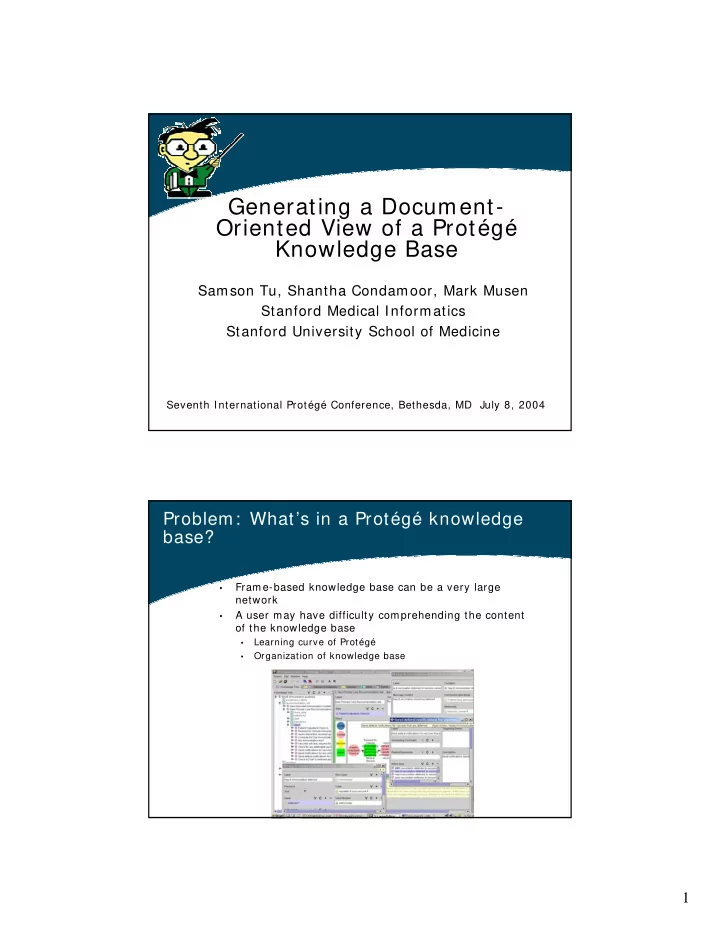

Generating a Document- Oriented View of a Protégé Knowledge Base Samson Tu, Shantha Condamoor, Mark Musen Stanford Medical Informatics Stanford University School of Medicine Seventh International Protégé Conference, Bethesda, MD July 8, 2004 Problem: What’s in a Protégé knowledge base? Frame-based knowledge base can be a very large • network A user may have difficulty comprehending the content • of the knowledge base Learning curve of Protégé • Organization of knowledge base • 1
Current state: Protégé allows limited views of knowledge bases Default classes/ instances tabs • Present tree-based views • Browse by classes and instances • Specialized views • Examples • • Diagram/ graph widgets • Instance tree tab/ widget • Ontoviz, Jambalaya tabs • Java-doc HTML generator Most expose a small amount of information • Most organized around Protégé modeling • constructs Alternative: Domain-oriented document views Expose content of knowledge bases as a documents • Organize documents around “rhetorical models” of • the domain Chapters and sections • Structured text • Graphics and tables • Index and glossaries • Convey large amount of information • Allow “reading” of knowledge base • Domain expert: can review KB content in a more • familiar medium Knowledge engineer: can review KB systematically • Literate knowledge engineering • 2
Outline of “KB2Doc” Work Problem domain • Design decisions • First experiment • Results • Methods • Assessment • Extensions • Current work • Future possibilities • Work in progress!! Problem domain: Guideline knowledge base Context: SAGE Project (www.sageproject.net) • Encoding of clinical practice guidelines (example) for • purpose of providing patient-specific decision support Structure of information • Guideline ontology and instances • Associated ontologies and KBs • • Patient data model • Model of organization resources • Medical terminologies Scoping decisions • Produce a document-oriented view of the content of a • guideline In Protégé term: expose content of an instance tree (all • frames referenced directly or indirectly from a root guideline instance) 3
Design criteria The document-generation capability should be • generic The document should expose the machine-readable • parts of Protégé knowledge base Multiple views should be allowed • There should be no modification to guideline • knowledge base The document should be “readable” on the web or as • printed document Pseudo-natural language and domain graphics • Mostly linear organization • • Trade-off between expansion of content at points of use and repetition First experiment: Results SAGE immunization guideline JCimmunization.html PRODIGY guideline for patients with previous myocardial infarction Curtsey of Neill Jones (SCHIN, University of Newcastle) PriorMI.html 4
Method of first experiment: How were the html pages generated Guideline KB jpeg files Java Program Guideline ontology XSLT HTML XML Annotations on guideline ontology Guideline ontology annotations: Document A “document” consist of a number of “sections” • A “section” specifies the “root” node • Two types of sections • Expansion of instances tree from the root node • (e.g. start from instances of Guideline class) Expansion of class hierarchy from the root node • 5
Generating ontology annotations: Classes Select “classes of interest” for annotation • Automatic generation of annotations, followed by • manual editing Selection and ordering of slots (for default text • generation) XML generation XML format: class and slot names as tags • < Decision p_id= "SAGEDiabetes_01535"> • < label> • Check if microalbumin testing due • < / label> • < description> • Checks to see if any urine protein test has • been performed in the last yr, or if any urine protein test in ordered within the next month. < / description> • < decision_model> • .... • < / decision_model> • < / Decision> • 6
Alternative annotations For selected classes, define alternative • annotations < Decision p_id= SAGEDiabetes_01535"> Check if microalbumin testing due < / Decision> Context-sensitive XML generation 7
Use of templates to generate text if absence of Goal HEMOGLOBIN A1C / HEMOGLOBIN.TOTAL: MFR: PT: BLD: QN: set goal for ‘HEMOGLOBIN A1C / HEMOGLOBIN.TOTAL: MFR: PT: BLD: QN: ’ as (0, 7.0] Percent after NOW Special treatment of graph widget Guideline • recommendations depicted as graphical flowchart-like format Handling of graphs • Generate images as jpeg • file Save coordinates of nodes • in special tags Transform to clickable • images in html 8
Document-generation integration into Protégé Guideline Workbench as a tab Specify annotations knowledge base and XSLT file Generate XML and HTML views of the guideline knowledge base Assessment: Satisfy design criteria? � The document-generation capability should be generic � The document should expose the machine- readable parts of Protégé knowledge base � Multiple views should be allowed � There should be no modification to guideline knowledge base ? The document should be “readable” on the web or as printed document 9
Assessment Clinician feedback: Not enough contextual • information about encoded guideline recommendations Purpose of guideline graphs different from paper • flowcharts Interpretations and encoding decisions not explicit • (no commented code) Maintenance problem • Annotation knowledge base has to track changes • in guideline ontology Simplistic document model • Brittle XML generation • Extensions: revised XML generation XML instances based on XML schema • generated from guideline ontology Schema-based transformations • “Protégé-independent” export format for guideline • instances Export, not backend • Conflation of class and metaclass • Single inheritance of subtypes • Relaxation of constraints • • Multiple allowed classes= > most-specific superclass • No overridden facet constraints 10
Extension possibilities Better integration into Protégé • Use of Protégé’s : ANNOTATION facility • A wizard to guide creation of annotation • knowledge base? Maintenance of annotation knowledge base • Document-oriented views of other large- • scale Protégé structures? Glossary of terms? • Clinical trial protocol documents? • Document-oriented knowledge acquisition? • Document-oriented views of Protégé knowledge base Simple annotations on Protégé ontology for • document generation Results of first experiment encouraging • Not completely satisfactory for clinicians • Useful tool for knowledge engineer • PRODIGY document much more polished • Potentially rich avenue of research • 11
Recommend
More recommend